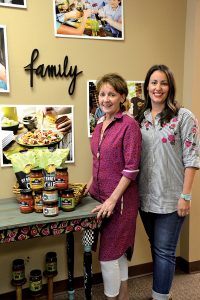The Supply Side: Bentonville-based My Brother’s Salsa poised for growth
by July 16, 2018 5:08 pm 2,749 views

Salsa never looked back after it was crowned king of the condiment category over ketchup more than 25 years ago. Increased consumer demand for Hispanic food sparked the growth, according to IBISWorld, and today the salsa industry brings in $3 billion in revenue each year, with an annual growth rate of 4.6%.
Ketchup revenue is projected to be just $8.9 billion this year, and the market is expected to decrease by 2% annually.
Helen Lampkin was on the cutting edge of the trend in the late 1970s when she began tweaking her brother’s recipe for salsa, canning it and giving it away to friends and family. When asked what it was, she would say, “Oh, it’s my brother’s salsa.”
Over the years, it became so popular that in 2003, her family encouraged her to take the salsa to market as a premium brand. She incorporated My Brother’s Salsa, and for the next six years was a one-woman operation, handling everything from sales to delivery. By 2011, the company was too much for her to handle alone.
“We either had to close it up and call it a day, or we were going to have do something serious,” said Ashley Pointer, Lampkin’s daughter and My Brother’s Salsa CEO.
At that point, Blake Pointer, Lampkin’s son-in-law and Ashley’s husband, decided to leave his career with Springdale marketing firm Saatchi and Saatchi X and join the family business full time as COO. He helped increase distribution from mom-and-pop shops like Miss Cordelia’s in Memphis, Tenn., to large retailers like Sam’s Club, Walmart, Target and Whole Foods. He also helped prepare the company for growth by moving co-packing operations and warehousing to larger facilities in Dallas.
Three years ago, the company was at a good place, so he turned over the reins to Ashley to be CEO. The Bentonville headquarters staff is made up of four employees, including Lampkin.

My Brother’s Salsa is available in about 2,000 Walmart stores across the country, and about 1,000 other grocery stores and outlets. The product line has expanded from the original salsa to 10 different flavors, including black bean and corn, New Mexican green chile, fire roasted and Helen’s rustic original, along with small-batch salsas including Hatch green chile, peach tomatillo, black bean Chimayo chile, cucumber tomato, cranberry orange and the original house salsa in mild, medium and hot. The company also makes its own whole grain tortilla chips.
STRATEGY
Concentrating on a few products and selling more of each is key to the business for Lampkin and Pointer.
The research findings by Packaged Facts indicate condiment and salsa consumers want natural, healthy foods that are multicultural, non-GMO and artisanal. That fits well into My Brother’s Salsa’s business strategy. Its product ingredients are natural, with no artificial colors or flavors. By the end of the summer, all products will be non-GMO verified.
Marketing the salsa as a “craft” product (think beer, wine or artisanal cheeses) differentiates My Brother’s Salsa from the many salsas on the market, Pointer said. “Tasting notes” are included on each jar that describe the flavor and texture of the product, and what other foods it would pair well with, as might be done with a bottle of wine.
“Usually, the most you can tell about a salsa is the heat level, but salsas are so much more complex,” Pointer said. “For example, fire-roasted has a charred, smoky taste, and we’ve found it’s good with avocadoes because they’re creamy, so they mix well with the smoky taste.”
No other brand does that, and Pointer said it elevates the whole category to “a little more high-brow level than the normal for salsa.” Posting recipes on social media to help cooks expand their use of the salsa is an additional part of the strategy.
Market research showed the Millennial consumer likes knowing the story behind a product, so telling Lampkin’s story and sharing the family’s collective love of gathering together around food resonates with consumers through the company motto of “Gather your people. Create a feast. Savor the moment.”
“That’s the bigger mission, because we know we’re selling chips and salsa,” Pointer said. “So, it’s not just salsa. There’s a story behind it, and there’s an emphasis on getting people back to the table.”
Lampkin continues to create recipes and invent new products. She also tastes every batch of salsa before it is shipped out to retailers.
“It’s her baby,” Pointer said.
DISTRIBUTION
With distribution in 2,000 Walmart stores across the country, the next move for My Brother’s Salsa is to increase business in grocery. Pointer said the company’s strongest distribution is in the South and Southeast, with some distribution in the Midwest; and Lowe’s, Weis Markets and Giant Eagle in the Northeast. Recently the company added Gelson’s Markets in Los Angeles and Harmons Grocery in Utah.
“We’re looking at all kinds of mainstream grocery, traditional grocery, the specialty and the natural [health food stores],” Pointer said. “We’ve been able to toggle across different channels.”
Being certified by the Women’s Business Enterprise National Council (WBENC) as a women-owned business, and therefore a diversity supplier, sometimes gives the company an edge with getting the product accepted by retailers, Pointer said. KeHE, United Natural Foods Inc., Valu Merchandisers Co., Avenue Gourmet and Horizon Foods distribute the salsa across the country.
Competition is steep with the multitude of national salsa brands and regional and local brands from small farmers. Pointer doesn’t see national brands as direct competition because “they are not as premium as we are,” but does feel competition from other local or regional brands.
Lampkin and Pointer made the decision early on to use quality ingredients and not add water or thickeners. That means the product has a higher price point, but Pointer believes being a premium product is a selling point because the salsa is more like what the consumer would make at home.
My Brother’s Salsa has enjoyed healthy, conservative growth of about 20% each of the past few years, Pointer said. This year, the company employed three sales people, located throughout the country, through a national sales agency to help grow the business. Pointer would like to add more big chains of 100 or more stores to the company’s portfolio, but she is equally excited about small retailers as long as it grows sales.
“We would love to be a true national brand, not just a regional brand that has distribution on both coasts,” Pointer said. “That’s always been my mom’s dream.”
––––––––––––––––––
Editor’s note: The Supply Side section of Talk Business & Politics focuses on the companies, organizations, issues and individuals engaged in providing products and services to retailers. The Supply Side is managed by Talk Business & Politics and sponsored by Propak Logistics.
